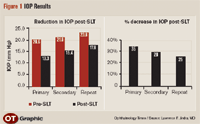Article
Research finds SLT all-around tool for glaucoma management
Chicago—Results of a study including more than 1,000 eyes followed for up to 3 years show that selective laser trabeculoplasty (SLT) performed with the Q-switched frequency-doubled 532-nm Nd:YAG laser (Selecta II, Lumenis) is a safe and effective option for lowering and maintaining IOP across a spectrum of glaucoma patients, reported Lawrence F. Jindra, MD, at the annual meeting of the American Academy of Ophthalmology.
Chicago-Results of a study including more than 1,000 eyes followed for up to 3 years show that selective laser trabeculoplasty (SLT) performed with the Q-switched frequency-doubled 532-nm Nd:YAG laser (Selecta II, Lumenis) is a safe and effective option for lowering and maintaining IOP across a spectrum of glaucoma patients, reported Lawrence F. Jindra, MD, at the annual meeting of the American Academy of Ophthalmology.
Dr. Jindra, assistant clinical professor of ophthalmology, Columbia University, New York, presented findings from a retrospective chart review that included 1,031 consecutive eyes treated with SLT between December 2001 and January 2005. Outcomes analyses were performed after dividing the total cohort into three groups represented by 486 treatment-naïve eyes, 429 eyes being treated with existing medical therapy and treated secondarily with SLT, and 116 eyes being treated with medications and that had a history of prior SLT or filtration surgery and underwent SLT as a repeat surgical procedure. Mean follow-up for the entire series was 217 days.

The patients in the primary treatment group ranged in age from 34 to 94 years (mean, 69 years). Mean IOP among the 486 eyes was 20.6 mm Hg at baseline and decreased by 7.3 mm Hg (35%) to 13.3 mm Hg at a mean follow-up of 251 days. In the secondary treatment group, the patients ranged in age from 24 to 95 years (mean, 71 years). Mean IOP pre-SLT in that group was 21.8 mm Hg and it was decreased by 6.4 mm Hg (29%) to 15.4 mm Hg after a mean follow-up of 188 days. Prior to SLT, these patients were using an average of 2.1 glaucoma medications, and that requirement was reduced by 60% at last follow-up when an average of 0.8 medications was being used.
In the repeat surgery group, patients ranged in age from 29 to 90 years (mean, 70 years). Mean IOP at baseline was 23.8 mm Hg and it was reduced by an average of 5.9 mm Hg (25%) to 17.9 mm Hg after a mean follow-up of 187 days. In that group, a 46% reduction in medication use was achieved, with the mean number of medications decreased from 1.8 at baseline to 1.0.
Dr. Jindra has continued to accumulate data from his SLT-treated cohort, and at upcoming meetings will be presenting findings from further analyses determining success/failure rates at various follow-up intervals post-SLT within his three study groups. So far, he has completed correlation analyses to determine potential factors predicting response. Those results indicate longer follow-up, higher pretreatment IOP, and fewer pretreatment medications are associated with a better response.
The study was performed with the assistance of Arusha Gupta, of SUNY Stony Brook School of Medicine. The presentation was chosen as one of the best posters in the glaucoma section by an AAO reviewing committee.
Newsletter
Don’t miss out—get Ophthalmology Times updates on the latest clinical advancements and expert interviews, straight to your inbox.





